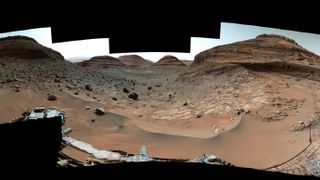NASA's Mars rover Curiosity reaches intriguing salty site after treacherous journey

After a treacherous journey, NASA's Curiosity Mars rover has reached an area that is thought to have formed billions of years ago when the Red Planet's water disappeared.
This region of Mount Sharp, the Curiosity rover's Martian stomping ground, is rich in salty minerals that scientists think were left behind when streams and ponds dried up. As such, this region could hold tantalizing clues about how the Martian climate changed from being similar to Earth's to the frozen, barren desert that Curiosity explores today.
The salty minerals that enrich this area of Mount Sharp were first spotted by NASA's Mars Reconnaissance Orbiter years before Curiosity touched down on the Martian surface in 2012.
Related: Curiosity rover: 15 awe-inspiring photos of Mars (gallery)
When Curiosity finally got a close-up look at the terrain of Mount Sharp, the rover discovered a diverse array of rock types and signs of past water, including popcorn-textured nodules and salty minerals such as magnesium sulfate, calcium sulfate (including gypsum) and sodium chloride, which makes up ordinary table salt.
After accounting for stresses on the rotary drill at the end of the rover's 7-foot (2 meters) arm that's used to pulverize rock samples for analysis, the Curiosity team selected a rock nicknamed "Canaima" for the drilling and collection of the mission's 36th drill sample.
"As we do before every drill, we brushed away the dust and then poked the top surface of Canaima with the drill," Kathya Zamora-Garcia, Curiosity's project manager, said in a statement. "The lack of scratch marks or indentations was an indication that it may prove difficult to drill."
Get the Space.com Newsletter
Breaking space news, the latest updates on rocket launches, skywatching events and more!
The team then stopped to see whether that posed a danger to Curiosity's arm. With a new drilling algorithm created to minimize the use of percussion, which is a hammering motion used by drills to penetrate hard surfaces, they decided to proceed, and no percussion was needed, Zamora-Garcia explained.
The team will now analyze pieces of the sample collected from Canaima using Curiosity's Chemical and Mineralogy instrument and Sample Analysis at Mars instrument.

Curiosity's summer road trip
To reach the sulfate-rich region, the Curiosity rover spent August journeying through a narrow, sand-lined stretch called Paraitepuy Pass. It took over a month for Curiosity to safely navigate this treacherous terrain, which snakes between high hills. Although Paraitepuy Pass is mostly free of sharp rocks that could damage the rover's wheels, sand can be just as hazardous for Curiosity; if its wheels lose traction, the rover could get stuck.
The rover's drivers also had another challenge to consider: The Martian sky was blocked by the hills around it, meaning Curiosity had to be carefully positioned so that its antennas pointed toward Earth and could remain in contact with Mars orbiters.
As the team carefully navigated this path, they were rewarded with some stunning images from Curiosity's Mastcam, particularly a panorama of the region captured on Aug. 14.
"We would get new images every morning and just be in awe," Curiosity's science operations coordinator, Elena Amador-French, who manages collaboration between the science and engineering teams, said in the statement. "The sand ridges were gorgeous. You see perfect little rover tracks on them. And the cliffs were beautiful — we got really close to the walls."
Despite clearing Paraitepuy Pass, Curiosity has a tough road ahead. This salty region comes with its own challenges — in particular, the rover's operating team will have to account for the rocky terrain that makes it harder to place all six of Curiosity's wheels on stable ground.
If Curiosity isn't stable, operators won't risk unfolding its drill-holding arm in case it clashes with jagged rocks.
"The more and more interesting the science results get, the more obstacles Mars seems to throw at us," Amador-French said.
Curiosity will continue to explore this area, proving that after 10 years on Mars, the rover still has a lot of ground to cover.
Follow us on Twitter @Spacedotcom and on Facebook.
Join our Space Forums to keep talking space on the latest missions, night sky and more! And if you have a news tip, correction or comment, let us know at: community@space.com.

Robert Lea is a science journalist in the U.K. whose articles have been published in Physics World, New Scientist, Astronomy Magazine, All About Space, Newsweek and ZME Science. He also writes about science communication for Elsevier and the European Journal of Physics. Rob holds a bachelor of science degree in physics and astronomy from the U.K.’s Open University. Follow him on Twitter @sciencef1rst.
Most Popular

